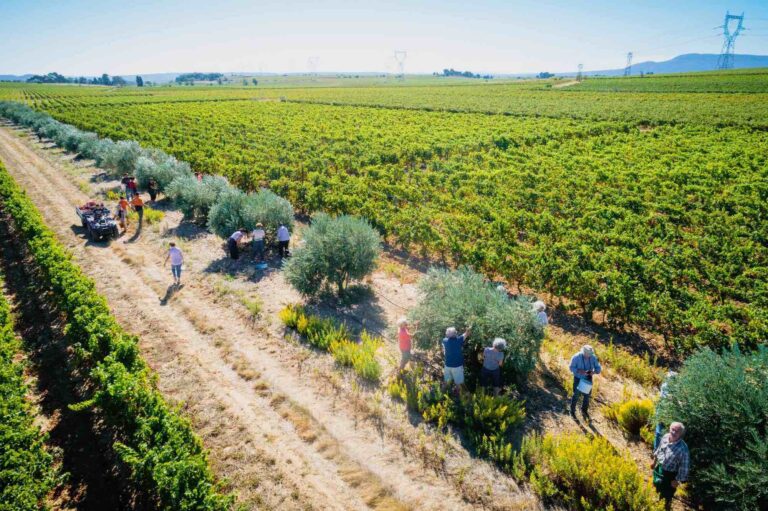
Visit to Tunia
2 July, 2019
Tunia is a domain located in the south-east of Tuscany, bordering Umbria. The estate, which belongs to Francesca Di Benedetto and Chiara Innocenti, covers 15 hectares of vines in one parcel.
When they took over the estate in 2009. The vines had been abandoned for several years. In the past, they belonged to the nuns of Florence who came to rest in the countryside of Arezzo, and Vin Santo was produced from their estate.
The vineyard is planted with old Sangiovese vines, not cloned, and old Trebbiano Rosa vines. Francesca and Chiara grafted Vermentino on part of Trebbiano Rosa to benefit from the old root system.
The entire production of the estate is artisanal; everything is handcrafted.



Update on the climate of the current vintage
December and January were warmer and drier months than normal, not one day saw negative temperatures!
March was a classic month and then followed April with high temperatures and a lot of rain.
May was cold, with two morning frosts. The plant that had budded in April stopped, the month looked like a month of November! These frosts have affected some of the buds, the vine has spread from the base and should not impact grape production.
June saw the return to the sunny and warm or even very hot, quite suddenly.
The vineyard shows a very good foliage development and a beautiful fruit load, which is quite remarkable on these old vines.

Organic work in the vineyard
The vines are fairly spaced between rows, ranging from 2.5 to 3 metres depending on the grape varieties planted, with spontaneous grassing in-between. Francesca organizes regular replanting every year to replace the missing ones and increase the yield as it goes along.The soils are calcareous, well draining with some deep clay-veins.Compost amendments produced at the estate are applied in December and January.Luckily, the vines and the region in particular are not very sensitive to mildew. The few copper treatments are blended with an infusion of horsetail, a plant naturally rich in silica.

Frost Prevention & Massal Selection
The whole vineyard is trained at waist-height. The frosts in May showed that these high prunings exist with reason: to avoid early frosts, which this year affected only the young vines that had not yet formed. All vines planted at waist height were located above the frost zone and therefore protected.Francesca and Chiara are aware of how lucky they are to have old vines that have not been cloned. Today, the new plantations are missal selection, chosen from the vine material of the domain. Trials were carried out last year to plant rootstocks and then graft on vines.
Unfortunately, the wound in the region is the presence of deer. Francesca saw 4 young deer recently grazing in the vineyards and eating the fresh shoots of the young vines!
These animals are a real plague when replanting because we cannot protect the vines with barriers as we do for wild boars. Deer can jump more than 4 meters!

A Labour of Love – Vin Santo
The estate produces a range of 6 vintages with the three colours, white, pink, red, as well as a bubble and a Vin Santo! The complete package! Vinifications are done in stainless steel tanks, concrete and casks, then assembled for maturing.
The estate produces a delicious Vin Santo. The grapes from the old vines of Trebbiano Rosa are harvested and dried in small boxes. Generally in January, the grapes are pressed and the must put into caratello – small 54-litre barrels. These Caratello wines have staves thicker than the usual barrels in order to resist the pressure produced during the fermentation of Vin Santo.
Fermentation is slow because the must is dense. The “Vin Santaia” (wine cellar for ageing Vin Santo) is under the roofs without insulation. Thus, during the winter when it is cold the fermentations stop, and in the summer when it is hot they resume.
Tunia keeps the wines fermenting well beyond the 3 years required by the DOC. The 2010 are still in caratello! The longer the maturation time, the finer and more complex the wine. A light yeast veil is created on the surface in the Caratello, it is an incomplete veil, closer to some yeast veil “spots” and very fine.
It should be noted that Vin Santo must is also used to make Sottofondo foam, the estate’s sparkling bubbles.




Tasting of the wines actually available
Sottofondo 2018 – traditional Trebbiano method, not disgorged
Sparkling orange wine with 5% base wine produced by skin maceration for one month.
Pied de cuve from Vin Santo must without yeast.
Good acid, fine bubble
Notes of dried apricot, quince, cedar. Solar wine.
Beautiful acidity on the palate, beautiful balance.
Chiaroscuro 2016 – direct-press rosé Cabernet Sauvignon
Nose of plum, spices, cherry
Supple attack, very cherry on the palate, acetate perception.
Chiarofiore 2014 – Trebbiano Rosa and Vermentino
Harvested in 4 stages and separate vinification of each harvest by skin maceration duration
Complex nose of aromas of sage, dried apricot, harmonious.
Tannic on the palate, silky tannins.
Chiassobuio 2011 – Sangiovese
Slightly reduced nose when opened but opening quickly.
Notes of liquorice, black fruits.
Tannic on the palate, supple tannins, notes of rosemary, thyme, liquorice and black fruits. Nice length.
Cantomoro 2010 – Cabernet Sauvignon
Wine to be served at room temperature.
Round and tannic mouth, with notes of tobacco, plum, cherry.
Not only wine …
Tunia is a typical Tuscan estate with a production of wine but also olive oil!
Recently, hives have also colonized the plot and a vegetable garden is under cultivation.
The vegetables are for family production but also to supply the restaurants in the region. In fact, tonight, Francesca is delivering courgette flowers to the Civitella restaurant Il Vicolo in Val di Chiana!


